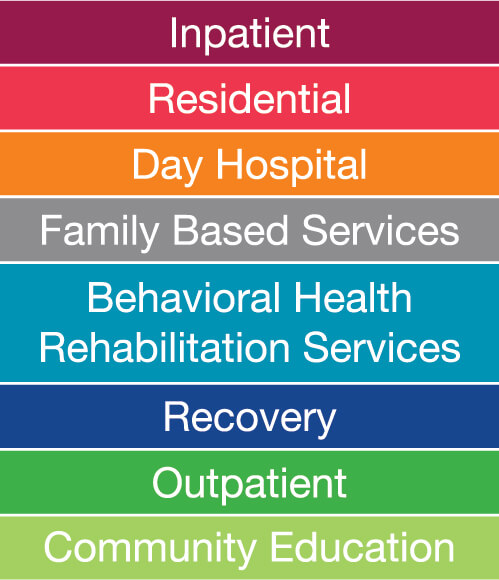A common challenge for many clients is navigating the mental health industry, especially after they themselves, or a family member has recently been in a state of crisis. To better understand the differences in levels of care, as well as potential practicum placement options for you, here is a breakdown on different treatment types, ranging from the least to most intensive. As levels of care get higher, differences will become apparent in terms of the level of involvement and stream of information you receive throughout the week.
A general thought within the behavioral health workforce is that treatment is the most effective in the least restrictive environment. As a result, it is common for patients who do not meet admissions criteria at one level to have had a similar experience prior to that. While we can recognize the disparities and problems in our current mental health system, unfortunately, our patients are the ones who tend to suffer.
Outpatient Therapist
Duration: 1 to 2 times/week, for one hour
These sites often are your standard “therapy” sessions, where you can go for an hour and have that person in your lief over an extended period of time. UNC offers many placements at outpatient therapy facilities, including private practices, group practices, private pay companies, Medicaid-serving facilities, with a specific age group or population, etc. Additionally, these placements will often have you managing your own caseload of patients over the semester.
Intensive Outpatient Program (IOP)
Duration: 3 to 4 times/week, for 3 hours minimum
IOPs can range in terms of their duration, hours, and feasibilities. Many of these begin in the afternoon and continue into the evening. There are both individual and group IOP programs, so common tasks may include facilitating group therapy sessions, assisting with stepping up or down to a different level of care through case management, and providing individual therapy alongside these programs to participants outside of group hours.
Partial Hospitalization Program (PHP) / Day Hospital
Duration: 5 days/weel, for 6 hours minimum
PHPs are relatively new, and not well-known, even among the mental health workforce. These serve as day programs, meaning that participants have much higher safety concerns than those solely in individual or IOP programs. Additionally, they run during the day, meaning they require an order from an LCSW, Psychiatrist, Psychiatric Nurse Practitioner, etc., in order to justify insurance coverage, temporary withdrawals from work/school etc. Common tasks may include running weekly group therapy sessions, carrying your own caseload of clients, managing a cohort of patients who are together for an extended period every day, working on an interdisciplinary team, and helping implement behavioral changes in a group setting.
Residential Treatment
Duration: 7 days/week, often for the entire time of enrollment of 6-8 weeks minimum
Residential care involves patients who stay in a specialized facility to focus on intensive treatment. Although these are commonly associated with eating disorders, substance use disorders, and patients with externalizing behavioral symptoms, many programs exist that are more specifically geared to specific conditions and behaviors. These opportunities have a large clinical staff, so a variety of opportunities within these placements exist, where extensive collaboration can help provide a great overview of different responsibilities for the future.
Inpatient Settings
Duration: 48-72 hours of 24/7 care
Inpatient services, or a hospitalization, is the highest level of safety concerns. Here, patients are given a psychological evaluation and screening, where they receive constant monitoring for their safety. Common tasks in these settings may include administering these evaluations, discharge planning, brief therapy sessions with patients and family members, and again, working on an interdisciplinary team.
While I did not include every single level in depth, this graphic also includes opportunities that include early intervention efforts, which can be delivered in the community or in a school setting. Finally, you may here LOC being used, which also stands for Level of Care, and refers the assessment process to determine if a specific level of care is appropriate for that client.


